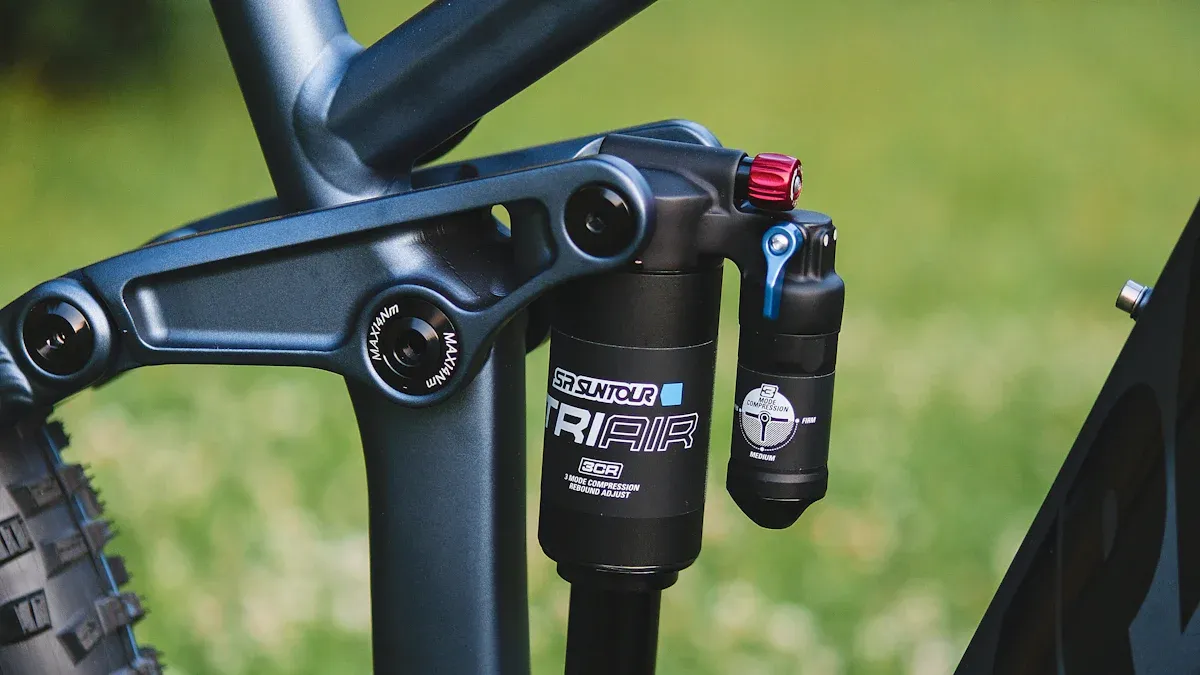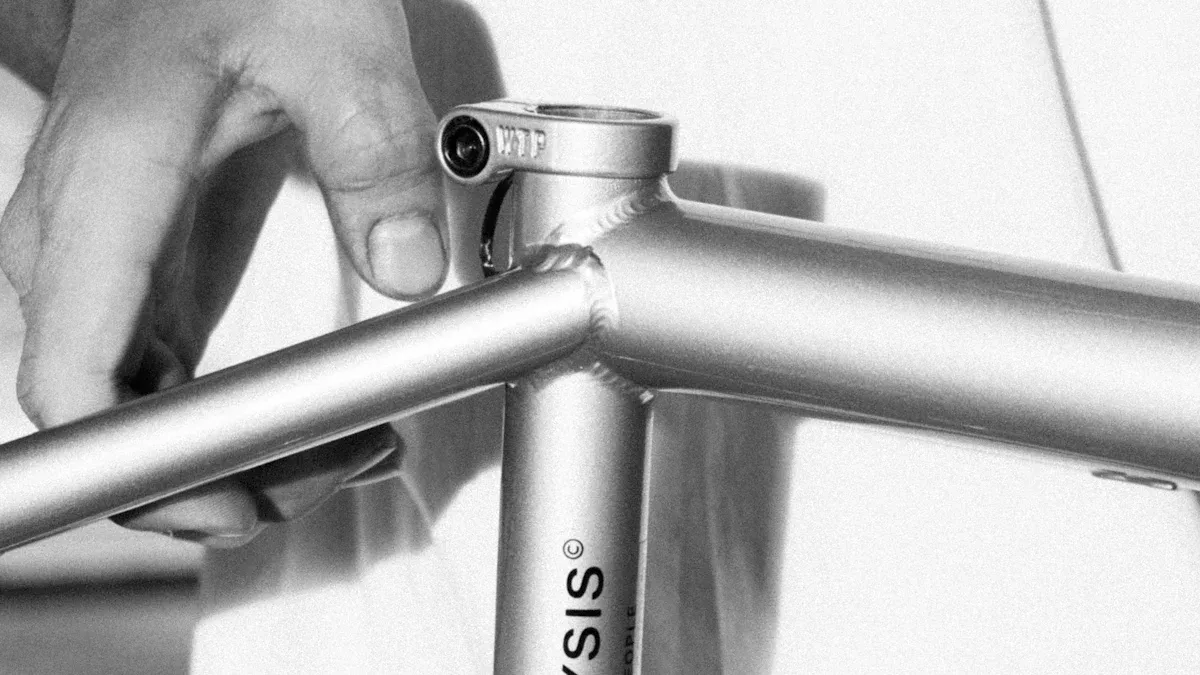
Choosing the right bike frame material is very important, especially when considering the differences between alloy vs carbon bike frames. It can change how well you ride, how comfortable you feel, and how much money you spend. For example, carbon frames are light and made for speed, making them popular with serious cyclists. On the other hand, alloy frames are strong and cheaper. You might see that materials like aluminum cost less, but they can wear out faster than carbon. In the end, knowing the differences between alloy vs carbon bike frames helps you make a smart choice for your riding style.
Key Takeaways
Carbon bike frames are lighter. They give a smoother ride. This makes them great for serious cyclists. These riders care about speed and comfort.
Alloy frames are usually made of aluminum. They cost less and last longer. This makes them a good choice for casual riders. They are also good for people on a budget.
Carbon frames soak up vibrations better than alloy frames. This means less tiredness on long rides. It also makes cycling more fun.
Think about your riding style and budget. This will help you choose between carbon and alloy frames. Each type has its own good and bad points.
Carbon frames work better but can be expensive to fix. Alloy frames are usually easier and cheaper to repair.
Carbon Frame Properties

Weight and Strength
When you think about bike frame materials, weight and strength are very important. Carbon frames are known for being strong and light. Most carbon fiber frames weigh about 3 lbs (1.3 kg) or less. This makes them some of the lightest choices. In comparison, aluminum frames usually weigh between 3.1 to 4 lbs (1400–1800g). Here’s a quick look at the average weight for different materials:
Material | Average Weight Range |
|---|---|
Carbon Fiber | About 3 lbs (1.3 kg) or less |
Aluminum | Heavier than carbon, around 3.1 to 4 lbs (1400–1800g) |
Titanium | Heavier than aluminum, varies a lot based on how it’s made |
But being light isn’t everything. Carbon fiber is also very strong. It can reach a tensile strength of up to 6,000 MPa. In contrast, aluminum alloys like 6061 and 7075 have strengths of 310 MPa and 572 MPa. This means carbon frames can take more stress without bending or breaking. This gives you confidence on tough rides. Check out this comparison:
Material | Tensile Strength (MPa) |
|---|---|
Carbon Fiber | Up to 6,000 |
Aluminum Alloy 6061 | 310 |
Aluminum Alloy 7075 | 572 |
Aluminum Alloys (General) | 90 to 700 |
Ride Quality
Now, let’s discuss ride quality. If you’ve ridden a bike with a carbon frame, you probably felt how smooth it is. Carbon fiber is great at reducing vibrations. This means it absorbs bumps from the road better than aluminum. This leads to a more comfortable ride, especially over long distances. Cyclists often say they feel less tired when using carbon frames compared to aluminum ones.
In fact, studies show that carbon fiber frames, like the Cervélo R5ca, send less vibration than regular aluminum frames. This makes your ride more comfortable, so you can enjoy it without the constant bumps from rough roads. Here’s a quick overview of how different materials compare in comfort:
Material/Component | Vibration Transmission | Comfort Level |
|---|---|---|
Cervélo R5ca Frame | Less buzz than R3 | Higher comfort |
Specialized Roubaix Fork | More comfortable than Easton EC90SL | Higher comfort |
Zipp 202 Wheels | More comfortable than Fulcrum Racing 7s | Higher comfort |
Alloy Frame Properties

Weight and Strength
When you think about alloy bike frames, weight and strength are very important. Usually, an aluminum frame weighs about 3.1 to 4 lbs (1400–1800g). This weight can change based on the frame’s design and size. For example, a regular alloy frame size might weigh around 48g, which goes up to about 52g with paint. Carbon frames are lighter, but modern aluminum frames still balance weight and strength well.
You might be surprised that aluminum alloys have a good strength-to-weight ratio. Carbon fiber is better in this area, with strengths up to 6,000 MPa. In comparison, aluminum alloys like 7075 reach about 572 MPa. So, while aluminum is strong, carbon fiber is much stronger and lighter. This makes carbon a popular choice for high-performance bikes.
Ride Quality
Ride quality is another key part of alloy frames. Modern aluminum frames have improved a lot in comfort. They balance performance and ride feel well. You’ll see they absorb some road bumps, but they may not be as smooth as carbon frames. Here are some features of ride quality in aluminum frames:
Strong and durable for lasting use.
Good mix of stiffness and damping to absorb bumps.
However, aluminum frames can feel stiffer than steel frames. The bigger tubes often used in aluminum make the ride feel harsher compared to smaller steel tubes. Still, new manufacturing methods have made modern aluminum frames better at absorbing vibrations. This means they offer a more comfortable ride than before.
Alloy vs Carbon Bike Frame Pros and Cons
Carbon Advantages
Carbon bike frames have many great benefits. These make them popular with serious cyclists:
Advantage | Description |
|---|---|
Carbon fiber is much lighter than steel or aluminum. This makes handling easier, speeds up rides, and helps during climbs or long trips. | |
Superior Strength and Durability | Carbon fiber is strong for its weight. It can handle stress without being heavy. It’s less likely to dent or bend in crashes and doesn’t rust, so it lasts longer than metal frames. |
Customizability and Innovation | Carbon fiber can be shaped into custom designs for different cycling needs. This allows for new ideas like hidden cables and special tube shapes that improve performance. |
Carbon Disadvantages
Even though carbon frames have many benefits, they also have some downsides:
High cost: Carbon fiber frames cost much more than aluminum or steel.
Vulnerability to impact: Carbon frames can crack from crashes or tight clamps, which might not show right away.
Expensive repairs: Fixing carbon frames can be costly and tricky, needing a professional check.
Reduced lifespan in harsh conditions: Sunlight and extreme temperatures can make carbon frames wear out faster than metal ones.
Weight considerations: While carbon frames are lighter, the weight difference may not be big when using mid-range parts.
Alloy Advantages
Alloy frames, especially aluminum, have their own benefits that many cyclists like:
Advantage | Description |
|---|---|
Lightweight | Lowers the total bike weight, making it faster and more efficient for riders. |
Stiffness | Helps transfer power well, allowing for quicker acceleration. |
Durability | Resists wear and tear well, good for many conditions. |
Affordability | Usually cheaper than other materials like steel. |
Versatility in design | Can be shaped into different designs for various types of bikes. |
Alloy Disadvantages
But alloy frames also have some downsides:
Aluminum frames wear out over time, making them less strong than steel.
They can be hard and expensive to fix, leading to throwing them away instead.
The ride can feel rougher compared to carbon or steel frames, which can be uncomfortable on long rides.
Over time, aluminum loses its stiffness, making the ride feel less direct.
Cheaper aluminum bikes often give a rough ride quality.
Weight Comparison
Overall Weight Differences
When you look at carbon and alloy bike frames, you will see a big weight difference. Carbon frames are usually lighter than aluminum ones. In fact, carbon can weigh up to a pound less than aluminum. This weight difference is important for cyclists who want to go faster and ride better. Here’s a quick look at the average weights of some popular bike frames:
Frame Type | Weight (kg) |
|---|---|
Carbon (Trek Emonda SLR 9 AXS) | 6.75 |
Carbon (Trek Emonda SL 7) | 7.97 |
Aluminum (Trek Emonda ALR 4) | 9.33 |
As you can see, the weight difference is easy to notice. This can really help when you are climbing hills or racing against others.
Performance Impact
The weight of your bike frame affects how well you perform. Lighter frames, like carbon ones, help you climb better. You will find that riding a carbon frame makes it easier to go up steep hills. High-performance bike frames made from carbon have a great strength-to-weight ratio. This makes them perfect for racing.
Here’s a quick comparison of how weight affects climbing performance:
Feature | Carbon Frames | Alloy Frames |
|---|---|---|
Weight | Usually lighter, helps with climbing | Heavier, but modern alloys are better |
Stiffness | Very stiff for better energy use | Good stiffness and durability |
Climbing Suitability | Great for racing or steep hills | Good for many riding styles, including climbing |
Durability Comparison
Carbon Longevity
Carbon bike frames can last a good amount of time. Normally, SAVA carbon fiber frames last about 10 to 12 years. If you take care of them, they can last even longer, around 10 years. But remember, carbon frames can be affected by their surroundings. For example, UV rays can damage the epoxy that helps them stay strong. Here are some important things to know:
UV rays can lower strength by up to 29%.
After 80 days in the sun, studies show a 23% drop in strength.
Strong sunlight can wear them down over time, making them less durable.
Alloy Longevity
Alloy frames, especially aluminum, have their own durability features. Usually, aluminum bike frames last between 5 to 10 years. They can be strong, but they might not last as long as carbon frames if cared for properly. Here’s a quick look at how aluminum does:
Aluminum frames can suffer from grain-boundary corrosion, which can cause quick failure.
Some aluminum alloys can resist wear better than regular aluminum.
Aluminum can rust, but it happens slower than the damage seen in some carbon frames.
Material | Corrosion Resistance | Fatigue Properties |
|---|---|---|
Aluminum | More prone to some types of corrosion | About 50% as good as steel |
Steel | Less affected by corrosion | Generally better fatigue properties |
Cost of Bike Frame Materials
Initial Investment
When you look at bike frames, the first cost can change a lot. Usually, carbon frames cost more than alloy frames. Here’s a quick summary of what to expect:
Carbon Frames: These usually start at about $2,000 and can go much higher for top models. They give good performance, but they cost a lot.
Alloy Frames: You can find beginner bikes under $2,000 that are often made from aluminum. These frames are cheaper and last longer, making them a good choice for many riders.
If you’re just starting or want to save money, alloy frames are often the best option. They offer decent performance without a high price.
Long-term Value
Now, let’s discuss long-term value. Carbon frames can be a smart buy for serious cyclists. They resist wear and don’t break down over time, so they can last longer if cared for. Here are some things to think about:
Carbon Frames: They usually keep their value better than alloy frames, especially high-end ones. But buyers often worry about hidden damage, which can lower resale prices.
Alloy Frames: While they might not last as long as carbon, they are usually cheaper at first. You can often use those savings for better parts, improving your bike’s overall quality.
In the end, think about how you will use your bike. If you ride a lot and want something that lasts, a carbon frame might be worth the cost. But if you ride casually, an aluminum bike frame could be the better choice for your budget.
Comfort and Ride Experience
Vibration Damping
When you ride a bike, comfort is very important. Carbon frames are great at reducing vibrations. They soak up shocks and bumps from the road or trail. This gives you a smoother ride. You can enjoy longer rides without getting tired. Carbon bikes lessen the vibrations that reach your body. This makes them perfect for rough terrains.
Less Vibration: Carbon frames send fewer vibrations to you. This leads to a more enjoyable experience.
Smoother Rides: You’ll feel less tired on long rides because carbon absorbs impacts well.
On the other hand, alloy frames send more vibrations. This can make your ride feel rougher, especially on bumpy trails. If you’re riding on rocky paths, an aluminum frame might not be as comfortable as a carbon bike.
Handling Characteristics
Handling is another key part of your ride experience. Carbon frames do well in this area too. They allow for quick acceleration and precise handling, especially on tricky terrain. The lighter weight of carbon bikes helps with nimble handling. This makes tight turns feel easy.
Responsive Handling: Carbon frames react quickly to your movements. This improves your control.
Stiffness: The stiffness of carbon helps with power transfer. This lets you speed up faster.
Alloy frames also provide good power transfer because they are stiff. However, they might bend under heavy loads. This can make handling less precise during tough rides. If you ride casually or often go on rough terrains, you might like the strength and lower cost of aluminum frames.
When picking between carbon and alloy bike frames, think about what is most important to you. Here’s a quick summary:
Weight: Carbon frames are lighter, which helps with speed.
Durability: Alloy frames are strong but can wear out quicker.
Repairability: Alloy frames are usually easier and cheaper to fix.
Cost: Carbon frames often cost more at first but can be better in the long run.
In the end, consider your riding style and budget. Whether you care more about performance or price, the best choice depends on your needs. Enjoy cycling! 🚴♂️
FAQ
What are the main differences between a carbon frame and an alloy frame?
Carbon frames are lighter and reduce bumps, making rides smoother. Alloy frames usually cost less and are strong but can feel harder. Each type has good and bad points based on how you ride.
How long can I expect a carbon fiber frame to last?
A well-cared-for carbon fiber frame can last about 10 to 12 years. But sunlight can weaken it over time. Taking care of it is important for a long life.
Are carbon gravel bike frames worth the investment?
Yes, if you want better performance and comfort, a carbon gravel bike frame can improve your ride. But think about your budget and how often you ride before making a choice.
What are the pros and cons of alloy gravel bikes?
Alloy gravel bikes are usually cheaper and last longer. However, they might not soak up bumps as well as carbon frames, which can make rides feel rougher on uneven ground.
Can I repair a carbon bike frame if it gets damaged?
You can fix a carbon bike frame, but it can be costly and tricky. It’s best to get a professional to check any big damage to keep it safe and working well.
See Also
Understanding The Differences Between Bike Frame Materials
Key Differences Between Fat Bikes And Mountain Bikes
Evaluating The Durability of Aluminum Bike Frames
